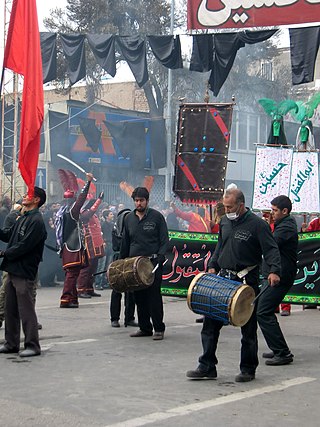Related Research Articles
A mosque, also called a masjid, is a place of worship for Muslims. The term usually refers to a covered building, but can be any place where Islamic prayers are performed, such as an outdoor courtyard.

The tambourine is a musical instrument in the percussion family consisting of a frame, often of wood or plastic, with pairs of small metal jingles, called "zills". Classically the term tambourine denotes an instrument with a drumhead, though some variants may not have a head. Tambourines are often used with regular percussion sets. They can be mounted, for example on a stand as part of a drum kit, or they can be held in the hand and played by tapping, hitting, or shaking the instrument.

Religious music is a type of music that is performed or composed for religious use or through religious influence. It may overlap with ritual music, which is music, sacred or not, performed or composed for or as ritual. Religious songs have been described as a source of strength, as well as a means of easing pain, improving one's mood, and assisting in the discovery of meaning in one's suffering. While style and genre vary broadly across traditions, religious groups still share a variety of musical practices and techniques.
Sheikh is an honorific title in the Arabic language, literally meaning "elder".
Madeeh is a song-like recitation of Islamic poetry praising Allah and the Islamic prophet Muhammad. Ethnomusicologist Artur Simon described madeeh as "praise, praise poem, glorification and, in this context, praise hymn in honour of Allah and Muhammad. It is usually recited by one male performer or a small group of men and may be accompanied by hand clapping or traditional hand drums.

The culture of the Republic of Djibouti is diverse, due to the nation's Red Sea location at a crossroads of trade and commerce.

The cultural setting of Saudi Arabia is greatly influenced by the Arab and Islamic culture. The society is in general deeply religious, conservative, traditional, and family-oriented. Many attitudes and traditions are centuries-old, derived from Arab civilization and Islamic heritage. However, its culture has also been affected by rapid change, as the country was transformed from an impoverished nomadic society into a rich commodity producer in just a few years in the 1970s. This change has also been affected by and the result of a number of factors including the communications revolution and external scholarships. The most recent ruler or king of Saudi is King Salman of Saudi Arabia.
The music of Montserrat is influenced by Irish traditions, noticeable in the set dance-like Bam-chick-lay, and the presence of fife and drum ensembles similar to the bodhrán. Natives are also witness to the jumbie dance, the style of which is still strongly African. Instruments include the ukulele and shak-shak, an African instrument made from a calabash gourd; both of these are used in traditional string bands. Calypso and spiritual-influenced vocal choirs, like the Emerald Isle Community Singers, are popular.

The music of Qatar is based on sea folk poetry, song and dance. Traditional dances in Doha are performed on Friday afternoons; one such dance is the Ardah, a stylized martial dance performed by two rows of dancers who are accompanied by an array of percussion instruments, including al-ras, tambourines and cymbals with small drums. Other folk instruments include the oud and rebaba, both string instruments, as well as the ney.

Islamic music may refer to religious music, as performed in Islamic public services or private devotions, or more generally to musical traditions of the Muslim world. The heartland of Islam is the Middle East, North Africa, the Horn of Africa, West Africa, Iran, Central Asia, and South Asia. Due to Islam being a multi-ethnic religion, the musical expression of its adherents is vastly diverse. Indigenous traditions of various part have influenced the musical styles popular among Muslims today. The word "music" in Arabic, the language of Islam, is defined more narrowly than in English or some other languages, and "its concept" was at least originally "reserved for secular art music; separate names and concepts belonged to folk songs and to religious chants".

Islamic culture or Muslim culture refers to the historic cultural practices that developed among the various peoples living in the Muslim world. These practices, while not always religious in nature, are generally influenced by aspects of Islam, particularly due to the religion serving as an effective conduit for the inter-mingling of people from different ethnic/national backgrounds in a way that enabled their cultures to come together on the basis of a common Muslim identity. The earliest forms of Muslim culture, from the Rashidun Caliphate to the Umayyad Caliphate and the early Abbasid Caliphate, was predominantly based on the existing cultural practices of the Arabs, the Byzantines, and the Persians. However, as the Islamic empires expanded rapidly, Muslim culture was further influenced and assimilated much from the Iranic, Caucasian, Turkic, Indian, Malay, Somali, Berber, and Indonesian cultures.

The rebana or terbangan is a tambourine that is used in Islamic devotional music in Southeast Asia, particularly in Indonesia, Malaysia, Brunei, and Singapore. The sound of the rebana often accompany Islamic ritual such as the zikir. The name rebana came from the Arabic word robbana. The rebana is also used by the Cham people of Cambodia and also gave rise to the Rabana which is used by the Sinhalese people of Sri Lanka.
Islamic religious leaders have traditionally been people who, as part of the clerisy, mosque, or government, performed a prominent role within their community or nation. However, in the modern contexts of Muslim minorities in non-Muslim countries as well as secularised Muslim states like Turkey, and Bangladesh, the religious leadership may take a variety of non-formal shapes.

Islam arrived in Kerala, the Malayalam-speaking region in the south-western tip of India, through Middle Eastern merchants. The Indian coast has an ancient relation with West Asia and the Middle East, even during the pre-Islamic period.
The culture of Mozambique is in large part derived from its history of Bantu, Swahili, and Portuguese rule, and has expanded since independence in 1975. The majority of its inhabitants are black Africans. Its main language is Portuguese. Its median religion is Roman Catholicism, but only about 40% of the inhabitants are Christian. It has a rich history in the areas of arts, cuisine, and entertainment.

Folk dances of Assam include the Bihu and the Bagurumba, the Bhortal, the Ojapali dance. Assam is home to many groups: Muslim, Indo-Aryan, Rabha, Bodo, Dimasa, Karbi, Mising, Sonowal Kacharis, Mishmi and Tiwa (Lalung) etc. These cultures come together to create an Assamese culture. Residents of the state of Assam are known as "Axomiya" (Assamese). Most tribes have their own language, although Assamese is the primary language of the state.

Arab folk dances, also referred to as Oriental dance, Middle-Eastern dance and Eastern dance, are the traditional folk dances of the Arabs in Arab world. Arab dance has many different styles, including the three main types of folklore, classical, and contemporary. It is enjoyed and implemented throughout the Arab region, from North Africa to the Middle East.

Music of Minang is a traditional and living genre of Indonesian music that grows and develops in the Minangkabau culture area. Music whose origins are related to Malay Music is generally played by musical instruments such as Talempong, Saluang, Minang rebab, Serunai, Tmbourine, Aguang, Gandang, and Violin. Minang music is also played to accompany various dances such as the Pasambahan dance and the Piring dance.
The relationship between Islam and music has long been a complex and controversial matter. Many Muslims believe that the Qur'an and Sunnah prohibit music ; however, other Muslims disagree and believe that some forms of music are permitted. Despite this controversy, music has been popular and flourished at various times and places in the Islamic world, often in palaces and private homes to avoid censorship.

The Dammam is a large double-headed cylinder drum or frame drum played by Shias in Iraq and Iran in religious ceremonies. The dammām is usually struck with the left hand and a curved stick in the right hand, especially during passion plays in the mourning month of Muharram or to wake up the devotees early in the morning of Ramadan.
References
- ↑ Simmons, Paulanne (4 February 2002), "Out of Africa: Mozambique troupe brings blend of traditional & contemporary dance", The Brooklyn Paper , retrieved 13 January 2010
- ↑ Cristalis, Irena; Catherine Scott; Ximena Andrade (2005). Independent women: the story of women's activism in East Timor. CIIR. p. 115. ISBN 1-85287-317-5.
- 1 2 3 Fitzpatrick, Mary (2007). Mozambique. Lonely Planet. p. 33. ISBN 978-1-74059-188-1.
- ↑ Correia, Amílcar (27 March 2003), "L'île magique de Vasco de Gama", Courrier International (in French), retrieved 13 January 2010
- 1 2 3 4 Sheldon, Kathleen E. (2005). Historical dictionary of women in Sub-Saharan Africa. Scarecrow Press. p. 247. ISBN 0-8108-5331-0.
- 1 2 3 4 5 6 7 8 9 10 11 12 13 14 15 16 Arnfred, Singe (2005). "Tufo Dancing: Muslim Women's Culture in Northern Mozambique". In Patraquim, Luís Carlos (ed.). Médias, pouvoir et identités. KARTHALA Editions. ISBN 2-84586-594-5.